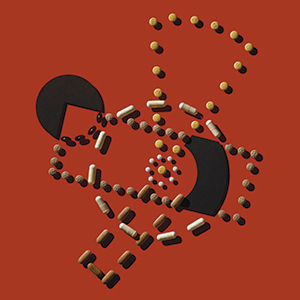Arts
The Freedom of Abstract Art
 Artist Tamara Staples' sister, Sherilyn, committed suicide. After her death, Staples created the pieces in 'Side Effects May Include' out of her leftover pills.
Artist Tamara Staples' sister, Sherilyn, committed suicide. After her death, Staples created the pieces in 'Side Effects May Include' out of her leftover pills.
There's an immediate sense of liberation, from logic and rationality, from meaning itself in a room full of abstract art. You can project nothing, something or everything at the busy, complicated canvases lining the walls.
The subject matter of Oliver Lee Jackson's paintings — colorful colliding lines and shapes — appears to be floating and drifting toward the canvas edges as if earth's gravity was about to escape. The exhibit Oliver Lee Jackson: Composed, Works from 1984 to 2016 also contains three sculptures, but their heaviness doesn't hold the same ocular allure as the painted works.
As you enter the gallery, Painting (12.19.84), 1984, an oil pastel, dominates the space. It acts against some similarly styled paintings as a patriarchal figure from which the smaller versions have sprung. A great mass of ochre, with smudges of green, turns restlessly in the center of the canvas. Demented black lines form spectral figures on top of this and other clouds of turbulent color. It could be a danse macabre or a Carnival parade in New Orleans. It's also worth mentioning how much white space Jackson leaves visible. The vibrant colors breathe it in like oxygen: it brings them to life and un-muddies them.
In the gallery opposite, a different kind of abstraction is taking place. Where Jackson's work is all old (if experimental) media—ink and oil and pigments—Sonic Futures means to entertain its audience with new media's breathlessness. Start with Jeepneys by Anna Luisa Petrisko. It's a 3 minute video installation that plays like a music video from 2057. The editing flashes in front of the eye like blasts of lightning. The future is posited as a place where attention spans no longer exist. You'll be able to comprehend the content if multitasker is your middle name.
Around the corner from this nest of hyperactivity: Laura Hyunjhee Kim's Love Networks Love, 2017. This 150-second video pairs mobile creativity with romance. When the anonymous tapping fingers type in, "A digital rose has no scent," is she longing for a real rose or extolling the infinite virtues of our imaginative online lives? After watching Love a few times, the images become strangely affecting. We spend too much time in front of our screens. Sonic Futures is filled with a dozen ways to remind us of that sad fact.
Tucked away in the Project Room at the back end of Sonic Futures is Tamara Staples: Side Effects May Include. It's only one ordinary room, but one that packs an emotional wallop. Staples' sister Sherilyn committed suicide in 2012. When she asked her brother-in-law to send her the contents of her medicine cabinet, there were 114 medications. The room Staples has created is a terrible wonderland made entirely of pills. Pills in an intricate design that pattern a dress. Pills forming a motif on the wallpaper. Pills covering a quilt, the curtains. Pills on every available surface of Sherilyn's last, psychic bedroom. Staples turns the addiction inside out.
For all the fast, immediate attractions of audio and video, it's Staples' small room that's most affecting. She's transformed a tragic inquiry about the nation's polypharmacy epidemic, and her grief, into a haunting epitaph for her sister.
Oliver Lee Jackson, Laura Hyunjhee Kim, Tamara Staples
Thru Jun 11, Free-$5
San Jose Institute of Contemporary Art


